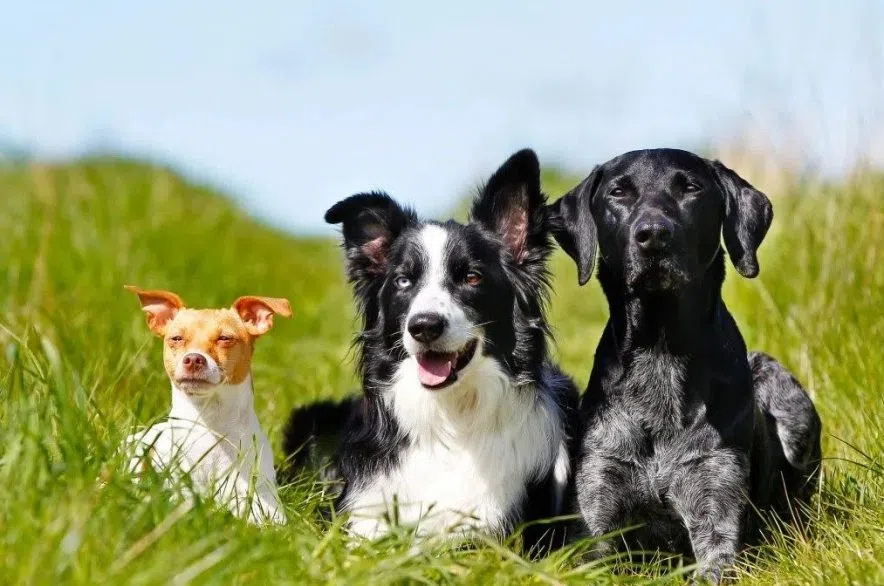While summer usually means a time of rest and relaxation for people, there are several things that could harm your pets during the summer months.
From parvovirus and the signs of heat stroke to blue-green algae and vaccinations, Dr. Cathy Dick, a wellness veterinarian and clinical instructor at the Western College of Veterinary Medicine, has the answers.
She joined the Evan Bray Show on Tuesday to share her advice and take questions on how to keep your furry friends safe this summer.
Read more:
- Ice treats, sprinklers, pools: How the Saskatoon Forestry Farm Park & Zoo keep cool
- It’s a dog’s life: SuperDogs keep their cool in the heat at Queen City Exhibition
- ‘No evidence’ of fires forcing wildlife closer to cities: Sask. Wildlife Federation
Listen to the full interview, or read the transcript below:
The following transcript has been edited for length and clarity.
EVAN BRAY: I saw a story recently about parvovirus really becoming an issue in Ontario. What is parvovirus, and is it an issue in our province?
CATHY DICK: Parvovirus is a virus that is everywhere in the environment. It’s carried by coyotes and dogs and it’s passed by what we call a fecal-oral route. It’s excreted in the feces and it contaminates the environment. And then our dogs – doing what dogs do, snuffling around, eating grass, digging – they can inadvertently infect themselves.
The virus likes to infect cells that are rapidly dividing, which happen to be in the GI tract, so we see a lot of signs of that disease in the GI tract. Bone marrow cells also rapidly divide, so it can then affect the immune system.
The primary group of dogs that are affected by it are puppies, because when you’re growing, guess what your cells are doing? They’re rapidly dividing.
The signs that you’re going to see associated with the GI tract are the loss of appetite, vomiting, diarrhea. The diarrhea is often bloody because the immune system is affected. Then they are prone to all kinds of secondary infections, so it is a potentially fatal disease, and yes it’s a problem in Saskatchewan right now.
What does treatment look like for this?
DICK: Treatment is supportive treatment. What you’re trying to do is support that puppy or that dog until its body can kind of mount that immune response and deal with the virus, so often that means hospitalization, IV fluids, some treating the secondary bacterial infections and just hoping that you can support that dog until its own body can kind of help fight that infection.
If we were to see a rise in cases in a certain area, would we see a release put out to make pet owners in the area aware?
DICK: Parvovirus has always been around. The biggest thing I would encourage people to do is to make sure that their animals are vaccinated. The virus can last for years in the environment. Cold winters do not kill it off. It lasts for years. In the spring, it kind of “reactivates” itself, and that’s when we often see a spike in cases.

Dr. Cathy Dick’s career initially started in medical school, but she changed her career path to focus on caring for animals about halfway through. As much as she loves animals, she said it’s important for vets to love working with humans, too. (Western College of Veterinary Medicine)
How do we protect pets from the heat and heat stroke?
DICK: Dogs and cats, unlike human beings, they’re not able to regulate their body temperature through sweating. They have a few little sweat glands on the pads of their feet. And when you look at dogs, the main way that they’re cooling themselves off is by panting. They can get really, really hot very, very quickly, like in a vehicle, but also if they’re left in the backyard that has no shade or no water.
The signs progress depending on how hot they get and how long they’ve been this way. The first thing you’re going to see is really heavy panting, and then their breathing will become really quite fast. They might drool a bit. Their gums might look like really bright red. They can be really unsteady on their feet. This can progress to muscle tremors, and even seizures and even death.
The big thing that you want to do is you want to get them cool, but you don’t want to do it too rapidly. So you’re not going to go dump them in cold water. If you can get room-temperature wet towels, you want to focus on their feet and on their underbelly. You want to get fans going to make sure that there’s air going over their body. You can also spray them with cool or tepid water.
If they aren’t responding, especially if you see tremors or if you’re able to take their temperature and it’s quite high, you need to be making your way to the veterinarian.
I got another question here from Lucy, who says, “I take lots of precautions. I do leave my dog out in our backyard. However, there are lots of shady areas that she loves to lay and rest. I also make sure I leave a lot of water out for her. She’s out for usually about four hours at a time. She’s a bigger dog, but I worry about the temperature of the water. Does that make a difference?”
DICK: It’s the evaporation that cools them down. If she’s really concerned, she could leave water in the shade that’s going to maybe not get as warm.
Blue-green algae can be a worry for pets. What is the tip that you have for people to help understand whether the water is safe for dogs to swim in and drink?
DICK: Blue-green algae is tricky, because there are some that are toxic and some that are not, but you can’t tell the difference just by looking at them. You’ll see blooms of them in stagnant water. If the water is stagnant, smelly, gummy, matted or has foam on it, I would completely avoid it. Basically, if you don’t really want to go in there, I wouldn’t let my dog in there either.
What about the air quality? We’ve had a lot of smoke in the air, and it’s something that we talk about as humans. How impactful is that on pets?
DICK: It’s the same for pets as it is for us, particularly birds because birds are really susceptible to agents in the air. If the quality is poor, I wouldn’t be letting my dog or cat hang out there either, and especially if you have an overweight animal or one of those pushed-in muzzle breeds, like a Persian or a little French bulldog.
How impactful can hot pavement or hot concrete be for pets on their feet?
DICK: It absolutely can burn their pads, and that’s really, really painful for them. And keep in mind, that’s where their little sweat glands are. You’re interfering with that means of cooling themselves as well.
I have heard that if you have your dog in the water and they drink too much water, it’s actually bad for them. Is this true? And is there any way I can prevent that from happening?
DICK: It is absolutely true. It’s something called water intoxication. If they swallow too much, they can get an electrolyte imbalance, which can lead to all kinds of medical issues, like neurological ones, and it can be potentially fatal. So the big thing to be mindful of is how much water that dog is consuming. The group of dogs to be particularly mindful of are really tiny dogs, or smaller dogs.
Eunice from Saskatoon says, “I’ve got a 15-year-old Pomeranian. He’s in pretty good health, strong heart, good hearing, still pretty spry for his age. He does have a cough, though, that lasts maybe 10 or 15 seconds a few times a day. It sounds like a cat coughing up a fur ball. Is that something to be concerned about?”
DICK: Coughing in an older dog can be caused by several different things, so I’d strongly encourage having him looked at by a veterinarian, just to rule out some of those things that it could be.
Here’s another question, this one from Rosie in Prince Albert. “About a month ago, our dog, which is a shepherd-husky mix, woke up limping, favouring his left front foot, and was whimpering. We’re not sure of the cause. We’d taken her for a walk the evening before, and she was fine. Since then, we’ve kept her inside with little activity. It seems to have gotten better. This last week up at the lake, she was running all over, seemed fine. Took her for a walk yesterday, no limp, and last night it started again. I’m not sure. Should we be taking her for X-rays or just try and control her activity?”
DICK: I think when you controlled her activity and it got better, that was a really good thing to do. The fact that it’s come back again is a good reason to have her checked out by a veterinarian, just to make sure that there isn’t anything else that you could be doing to help prevent the problem, or even to help cure the problem.
Terrence with a text saying, “I own two German Shepherd dogs. Should I be giving them supplements for their hips?”
DICK: German Shepherds are prone to something called hip dysplasia, which is a name for arthritis in the hips. Joint supplements can help, but actually, the single most important thing that you can do for those dogs is to keep them at an ideal body weight and to maintain moderate exercise. That, in the long run, is probably going to do the most for their hips.
I’ve got a text from Susan in Saskatoon, saying, “I’ve seen an increasing number of foxtails in Saskatoon. What can we do to prevent contact with those? Are they dangerous for pets?”
DICK: Foxtails are dangerous. They’re a barb, and if the dog chews them, inhales them or walks on them, they can work their way through that tissue, and they don’t come back out because of the way their barbs are. The only way to treat them is to have them removed, and sometimes they can be quite difficult to find, especially as they migrate through the body.
Another question here from a texter saying, “I’ve read that vaccinations are not required on a yearly basis, and in fact, may cause some problems by vaccinating too often. What would your recommendation be?”
DICK: Vaccines are really, really important. They prevent really nasty diseases. The most important vaccine series, I think, is the puppy series. Typically, they’re vaccinated at eight to nine weeks separated, three to four weeks apart. The last one you want them to be 16 weeks old. There are many different vaccine protocols out there.
At the Small Animal Clinic, what we do is when they come back at a year, we do a three-year rabies and a three-year distemper/Parvo. And then thereafter, as long as you keep it up to date. We go every three years. Vaccines, like any kind of treatment, yes, there are side effects to vaccines. However, the risk of the disease far outweighs the risk of the vaccine, so I am very much in (favour of) vaccinating our cats and dogs to prevent the disease out there.
Another texter here says, “I’ve got a little Chihuahua purebred and he sheds year-round. Is there something I can do to slow that down, or is that just what they do?”
DICK: The biggest thing that you can do is feed them a healthy diet, brush them regularly and keep their coat really nice and healthy. But they’re going to shed; that’s what dogs do.
Another texter here saying, “I like to feed my dog table scraps as a treat. We normally feed him dog food as regular food, but I will slip table snacks to him, even though my wife scolds me and tells me not to. Am I hurting my dog by doing that?”
DICK: It depends on how much table scraps you’re feeding. More table scraps adds calories, and it can add to the weight of your pet. Secondly, it depends on what you’re feeding them, like, especially really fatty foods. Some dogs are more prone to developing something like pancreatitis.
You don’t want to feed cooked bones. If the dog is chewing on them and shatters them, it can break their teeth and bone fragments can perforate the bowel. That can be really unhealthy as well. Depending on how much of their diet is table scraps and how much of it is food, you can also affect the nutritional balance of the nutrients that they’re getting.
We’ve got another diet question but this time about cat food. A texter asks, “What’s a good cat food brand? Most of them seem like they’re not even food. They’ve been processed. So much is there maybe a good homemade mixture?”
DICK: The biggest thing is making those diets complete and balanced, and that is where the challenge comes. If I do have owners who want to home cook for their pets, I send them to a veterinary nutritionist to have a diet formulated for them that’s actually complete and balanced, because if it’s not complete and balanced, over time that is going to have a negative impact on the pet.











